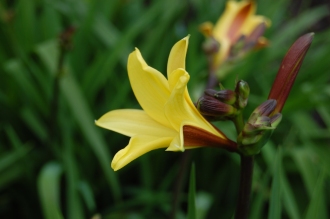Position: Full sun too light shade
Flowering period: Late spring
Soil: Moist, poorly drained
Eventual Height: 1.5m
Eventual Spread: 1m
Hardiness: 5a, 5b, 6a, 6b, 7a, 7b, 8a, 8b, 9a
Family: Saxifragaceae
Darmera peltata is a deciduous perennial with a clump forming habit. Its dark green leaves are rounded, deeply lobed, with doubly serrate margins and up to 45cm across. Its leaves turn red in autumn before they wither. Its pink/ white flowers are up to 15mm across, appear as cymes on tall stems and appear just before the leaves. Its roots are rhizomes which aids its spread.
Darmera peltata, commonly known as Giant Cup, Umbrella Plant or Indian Rhubarb, is native to western USA. In its native habitat it grows on mountain stream sides in woodland. Darmera peltata is the only species within this genus.
The etymological root of the binomial name Darmera is named after Karl Darmer (1843 1918), a German horticulturist. Peltata is derived from the Latin pelta meaning ‘crescent shaped shield’, in reference to its leaves.
The landscape architect may find Darmera peltata useful as a marginal plant in damp or bogy areas.
Ecologically, Darmera peltata flowers are attractive to pollinating insects.
The Royal Horticultural Society has given Darmera peltata their prestigious Award of Garden Merit in 1993.
Darmera peltata prefers moist, fertile, poorly drained to boggy soils. It tolerates most pH of soil. It dislikes dry soils.
Darmera peltata requires little maintenance. Large clumps may be divided in spring.











